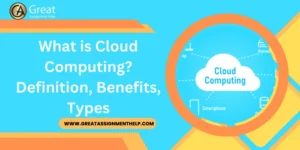Cloud computing is one of the trending technologies in the modern digital world. Since this technology offers several benefits, nowadays, several companies have been using a lot of cloud-based applications and IT services. In case, you don’t know what cloud computing means, explore this blog and update your knowledge. Here, we have shared what is cloud computing and its definition, benefits, and types.
What is Cloud Computing?

The utilization of hosted services, including servers, databases, networking, software, and data storage via the Internet is referred to as cloud computing. Usually, a cloud service provider manages the physical servers where the data is stored. In cloud computing, computer system resources, particularly data storage and processing power are made available on-demand and are not directly managed by the user.
To put it in simple terms, instead of purchasing, running, and maintaining physical data centers and servers on-site, users can get technology services like databases, computing power, and storage from cloud providers with pay-as-you-go pricing.
The primary goal of cloud computing is to offer quick and scalable access to IT services and computing resources. Especially, for the effective deployment of a cloud computing platform, the cloud infrastructure uses both hardware and software elements.
Also Read: What are the Different Types of Coding Languages?
Cloud Computing Architecture and Working Process
So, how does cloud computing work? Typically, through the internet, cloud computing enables client devices to access computational resources that have been rented, including data, analytics, and cloud apps. In specific, it depends highly on a network of distant data centers, servers, and storage units that cloud service providers own and run. Moreover, the service providers hold the responsibility to maintain the processing power, storage capacity, and security that data users transmit to the cloud.
To understand the cloud computing architecture and the steps involved in the working of cloud computing, take a look below.
- An internet network connection connects the front end with the back end. The front end provides an interface for accessing client devices, browsers, networks, and cloud software applications. The back end includes databases, servers, operating systems, and computers.
- Furthermore, the back end serves as a repository for storing data accessed through the front end.
- A centralized server handles communication between the front and back end. Particularly, to simplify data exchange, it uses protocols. The central server manages connectivity between client devices and cloud servers through the use of both software and middleware.
- Each application or task always contains a dedicated server.
Cloud computing is highly dependent on automation and virtualization technologies. Especially, through the use of software known as a hypervisor, virtualization enables IT organizations to construct virtual instances of servers, storage, and other resources, enabling numerous virtual machines (VMs) or cloud environments to run on a single physical server. This makes it easier for users to request and use cloud resources by streamlining the abstraction and provisioning of these resources into logical entities.
Also, automation and orchestration capabilities enable customers to supply resources, link services, and deploy workloads without requiring direct interaction from the cloud provider’s IT team.
Types of Cloud Computing
Cloud Computing is broadly categorized into two types based on the following
- Deployment Model
- Service Model
As per the deployment model, the cloud computing is classified into various types
- Public Cloud
- Private Cloud
- Hybrid Cloud
- Community Cloud
- Multi-Cloud
Furthermore, based on the service model, the cloud computing is divided into the following
- Infrastructure as a Service (IaaS)
- Platform as a Service (PaaS)
- Software as a Service (SaaS)
- Function as a Service (FaaS)
In the upcoming sections, let us look at each one in detail.
Different Types of Cloud Deployment Models
The following are the various kinds of cloud computing deployment models.
Public Cloud
The term “public cloud” describes computing services provided by third-party vendors via the Internet. In general, public clouds allow anybody to utilize or purchase their services for free or on demand.
When using the public cloud, the customers can pay only for the CPU cycles, storage, or bandwidth they utilize. Additionally, the public cloud provides flexible bandwidth and expandable RAM, which helps enterprises scale their storage requirements.
Some popular public cloud service providers are AWS, Google Cloud Platform (GCP), IBM, Microsoft Azure, Oracle, and Tencent Cloud.
Private Cloud
The term “private cloud” refers to the computing services provided by a private IT network for the exclusive use of a single organization. It is also called an internal, enterprise, or corporate cloud.
Usually, a private cloud is managed by internal users and not anyone outside of the organization. However, internal users may be billed for services via IT chargeback. With the help of a private cloud, a company can build and manage its own cloud infrastructure.
Private cloud offers a high level of security through company firewalls and internal hosting. Furthermore, it provides several other benefits such as self-service, scalability, elasticity, additional control, and customization.
Private cloud technologies and suppliers include VMware and OpenStack.
Hybrid Cloud
A hybrid cloud combines on-premises private cloud infrastructure and public cloud services for better orchestration and automation between the two.
Businesses can use the public cloud to manage workload bursts or demand spikes. On the other hand, the private cloud can be used for running sensitive apps or mission-critical workloads.
The primary aim of a hybrid cloud is to create a unified, automated, and scalable environment that leverages the full potential of public cloud infrastructure while controlling critical data.
Community Cloud
A community cloud is a computing service shared by multiple enterprises. It mainly serves a specific community with shared goals, regulations, security needs, and compliance issues.
A community cloud can be built on or off campus. Moreover, it can be run either by a particular company or by a reliable third-party vendor.
Multi-Cloud
Organizations are increasingly adopting a multi-cloud approach, which involves the usage of numerous IaaS providers. The multi-cloud typically allows programs to migrate between cloud providers or run concurrently on two or more cloud providers.
Furthermore, by using multi-cloud, businesses can reduce the risk of a cloud service outage and take advantage of more competitive pricing from a specific provider. It also helps enterprises avoid vendor lock-in by allowing them to switch from one source to another as needed.
Also Read: What are the Different Types of Writing Styles?
Various Types of Cloud Service Models
Find here, the several types of cloud computing services.
Infrastructure as a Service (IaaS)
In this kind of cloud computing service, networking, storage, and servers are all handled by a service provider via a virtual interface. Moreover, with this service, the users can control the storage, operating systems, and installed apps without worrying about managing the cloud infrastructure.
A third-party provider hosts the servers, storage, software, hardware, and other infrastructure components rather than the user. Additionally, the vendor keeps a backup copy and hosts the user’s applications.
Amazon Web Services (AWS) is a popular IaaS provider.
Platform as a Service (PaaS)
The PaaS paradigm allows cloud service providers to host development tools on their infrastructures. Users can access this service via APIs, web portals, or gateway software.
Primarily, many companies use PaaS for general software development. Even, PaaS providers host the software after its development.
Some PaaS products include Salesforce Lightning, AWS Elastic Beanstalk, and Google App Engine.
Software as a Service (SaaS)
SaaS is a distribution paradigm that uses the internet to offer software applications, which are also known as web services. Simply, with the help of an internet-connected PC or mobile device, users can access SaaS applications and services from anywhere.
Furthermore, the SaaS model provides consumers with access to application software and databases.
Microsoft 365 which offers email and productivity features is an example of a SaaS.
Function as a Service (FaaS)
FaaS or serverless computing allows users to run code on the cloud without worrying about the underlying infrastructure. Customers can create and use functions that react to triggers or events.
FaaS removes the need for server and infrastructure management. Also, it enables developers to focus only on writing code.
Benefits of Cloud Computing
For businesses, cloud computing provides several benefits as listed below.
- Reduces capital costs
- Provides quick and flexible scalability
- Improves business collaboration and interaction
- Enhances the value of business
- Offers unlimited storage capacity
- Easy data backup and restoring
- Competitive Edge
- Sustainability
- Offers High Security
- Easy to access
- Mobility
- Good Quality control
- Disaster Recovery
- Prevents loss of data
- Allows automatic software updates
List of Popular Cloud Computing Service Providers
The following are some well-known cloud computing service providers
- AWS
- GCP
- Azure
- Alibaba
- IBM
- Citrix
- Rackspace
- Salesforce
- SAP
- VMware
Cloud Computing Applications
Find here some notable cloud-based applications that many people have been using extensively in recent times.
- Google Docs
- Microsoft 365
- Calendar
- Skype
- Zoom
- AWS Lambda
- Salesforce
Conclusion
Hopefully, by now, you will have gained a good understanding of what is Cloud computing and its definition, benefits, and types. In case, you have any doubts about cloud computing, feel free to contact us. We have numerous skilled software and technical experts on our team to provide quick and valid clarifications.


